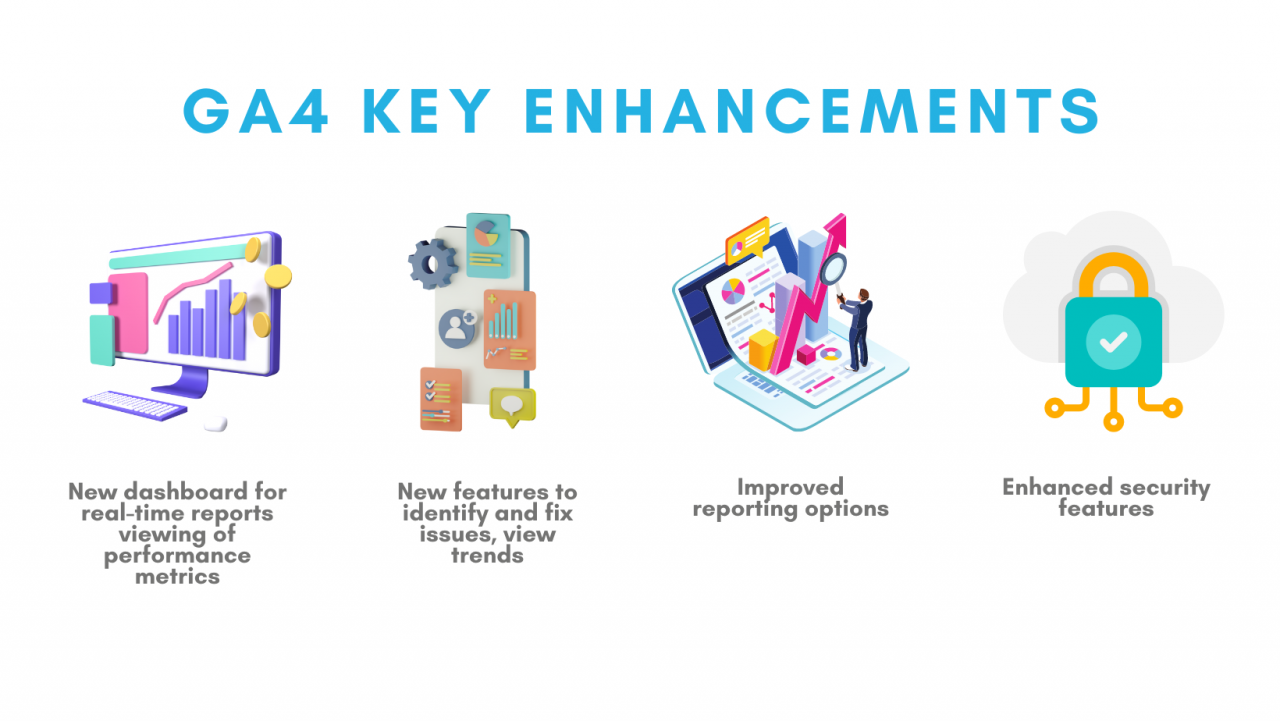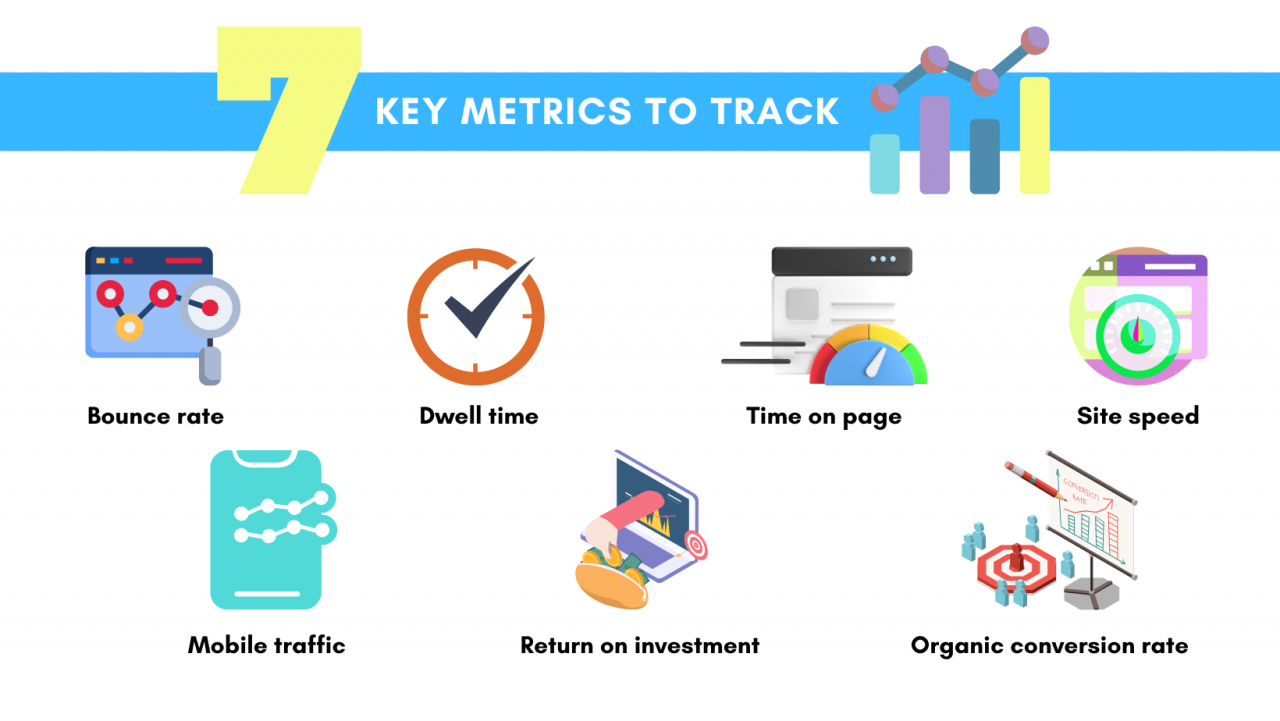
On July 1, 2023, Google Analytics 4 (GA4) will take over the all-important role of providing you with data on your website’s performance and user behaviour. This is a big deal because it means that Google can provide more accurate information about your site’s performance than ever before.
Universal Analytics was built for a different era where most people still used desktops and browsers to access the internet. In today’s mobile world, measuring traffic based on what device someone uses doesn’t make sense.
Google Analytics 4 is built for a new generation of measurement that is anchored in the browser, independent sessions and less easily observed data from cookies. It delivers user-centric measurement, including unique insights into how visitors engage with your site and apps.
The latest release of Google Analytics 4 introduces several key enhancements, including:

- A new dashboard allows you to view real-time reports and segmentation criteria while viewing performance metrics such as conversions, eCommerce transactions and goals.
- New features that help you identify and fix issues faster, like seeing trends over time within individual segments.
- Improved reporting options allow you to customise your dashboards and views to reflect your specific needs.
- Enhanced security features enable you to precisely control what information is shared with whom.
Google Analytics 4 Improves Data-Driven Marketing Strategies
The latest version i.e., Google Analytics 4, offers businesses a way to target customers based on where they are located, what devices they use, how much money they spend and other factors. This information can help marketers determine which strategies work best for different types of customers. For example, those who live near a store might receive targeted ads about discounts and sales. And mobile users could see special deals tailored to their needs.
Google Analytics 4 also gives marketers insights into how well each ad campaign performs compared to others. If one ad doesn’t perform well, it can be removed from future campaigns. In addition, marketers can now view data for multiple accounts within a single report. These improvements make it easier to compare performance across channels and campaigns.
In short, Google Analytics 4 makes it possible to measure and optimise marketing activities. To know what has changed with Google Analytics 4, click here.
If you have questions about the impact of Google Analytics 4, please leave them below. We’d love to hear from you! Get answers to your Google Analytics 4 questions.
Google Analytics 4 and SEO
What is SEO Analytics?

Before we dive into how to set up and use Google Analytics for SEO, let’s take a quick look at what SEO analytics entails. SEO analytics is collecting, analysing, and reporting your site’s performance across multiple channels, including social media, paid advertising, email campaigns, and many more.
SEO analytics is important because it helps you determine whether or not your digital marketing strategy is working. If you’re trying to increase sales online, you’ll want to ensure you’re reaching your target audience and driving conversions. You do this by identifying specific keywords that are bringing people to your site and using those keywords to optimise your copy and landing pages.
Google Analytics is one of the best options for getting a handle on your website’s performance and optimising your SEO strategy. You can see where your visitors come from, how long they spend on your site, their devices, and even how they got to your site.
You can also use Google Analytics to monitor your conversion rates and compare different versions of your web pages. For example, you might notice that some of your landing pages perform better than others. Or maybe one version performs much better than another.
With Google Analytics, you can easily see which version of your webpage performed better and adjust accordingly. You can also use the tool to analyse your competitor’s sites and find out what types of strategies they’re employing.
In addition to viewing your website’s statistics, you can use Google Analytics Reporting to present your SEO data to clients and colleagues. This way, everyone involved can see exactly what each person did to grow the site’s rankings.
How Does Google Analytics 4 Help SEO?

Google Analytics is one of the best tools for tracking your web traffic. It gives you insights into your audience, where they’re coming from, what keywords they’re typing, and even what devices they’re using. All of this helps you make decisions about your online marketing strategy. Here are some ways that Google Analytics can help improve your SEO.
15 Ways To Track Your SEO Efforts Using Google Analytics
-
Sync your Search Console account
The first tip for measuring SEO with Google Analytics is to connect Analytics to Google Search Console. This will help you identify opportunities for improvement.
- Use landing page URLs to track conversions.
- Analyse your mobile traffic.
- Measure the ROI of your PPC campaigns.
- Make sure your site is responsive
- Track your paid ads with AdWords
- See your conversion rates
- Improve your bounce rates
-
Create SEO-related goals
“You must set up some goals related to SEO,” says Sheehy. “For example, I might say, ‘I want to see my site ranked number one within three months.’ Then I’ll make sure that I monitor that goal daily. If I’m getting a lot of visits from people searching for, then I know that I’m doing something right.”
“If you’re looking to increase conversions, then you need to focus on increasing the number of leads you receive,” adds Tabnernor. “So, you could use a tool like Leadpages to capture contact information and send follow-up emails automatically. This helps you save money while driving more leads and ultimately increasing sales.”
-
Use the organic visitor segment
Vic Spall of Browser Media says there are two main ways to deal with spam traffic: filter it out or keep it in. Filtering it out is easy; just add a filter to your report that excludes traffic that doesn’t match your hostname. However, keeping it in could mean losing some helpful information.
“When using Google Analytics for SEO,” he explains, “I recommend ensuring that you are using segments & filters to remove spam traffic.”
Spall explains that there are two main types of spam traffic: crawlers and fake referrer spam. Crawler spam is where someone visits your site via a link from another site, and fake referrer spam happens when someone visits your site directly. Both types of spam traffic will wreck your reports.
The best way to stop both types of spam traffic is to ensure you’ve got good filters in place.
“If you don’t want to lose data, I’d suggest setting up a new view in GA that uses the organic visitor segment,” he suggests.
“Segments are your friends,” he concludes. “They allow you to see how visitors behave over time and let you compare how one group behaves against another.”
-
Compare organic visitors to non-organic
Google Analytics lets you see how many people come to your site via organic searches versus paid ads. If you notice a significant drop in organic visits, it could mean something is wrong with your site. For example, if you’re seeing fewer people come to your site via organic search because they find your competitors’ sites better, you might want to focus on improving your site.
-
Find top-performing content (and update it)
When we asked Shotkit for their favourite SEO tips when using Google Analytics, Rachel Kaiser recommended regularly looking at your top-performing pages. “There might be something you could change to make them even better,” says Rachel Kaiser. “Maybe that’s updating them with fresh content, and maybe it’s adding a stronger call to action—whatever you need to do to get maximum return from the areas of your website that are already ranking in search and keep them in the top results.”
Google Analytics lets you look at your top-performing web pages in several ways. First, you can view your top-performing pages by day, week, month, quarter, and year. This helps you identify trends over time. If you’re interested in seeing how each webpage performed during a specific period, you can use the Top Pages report. There’s also a Top Content Report, which gives you a snapshot of your top-performing content based on keywords.
If you want to dig deeper into your data, check out the Keywords section of the Audience Overview report. Here you’ll find information such as the number of unique visitors per keyword, average session duration, bounce rates, and much more.
-
Look at top-performing landing pages
According to BforBloggers ‘Aayush Bhaskar, tracking your best landing pages is among the most underrated SEO tricks. He explains that this data can help you increase traffic, decrease bounce rates and identify top and least performing pages. For example, he goes through his top landing pages a month and optimises the top ten for readability and user intent, conversion, Google’s freshness algorithm, and keeping the article up to date.
-
Use the Content Drilldown report
The Content Drilldown report gives insights into how people found your blog post. You can use it to learn about the most popular keywords, discover where visitors come from, see how many times a specific keyword appears on your site, and much more. This tool helps you understand your audience and optimise your content strategy.
You can access the Content Drilldown report directly within Search Console.
-
Add annotations to track content updates
Google Analytics allows you to add annotations to track the success of your content updates. Annotations allow you to see how many times a piece of content appears across different channels, such as social media, email newsletters, etc. You can even compare the performance of one version versus another.
From there, you choose the type of data you want to collect and select the channel where you want to view the information. For example, I added my blog posts to the Annotations tab.
You can also create custom annotations. To do this, go to the same section of analytics, and scroll down to Custom Annotation. Several options include URL, Page Title, Category, and Metrics.
In addition to adding annotations, you can also export your data into Excel. This allows you to analyse the data further or import it into other tools such as Data Studio.
-
Use the multi-channel funnel report
The multi-channel funnel report is one of the best ways to see what happens when someone visits your site, engages with your content, and converts.
You can use the same data to understand where people are coming from, whether they’re returning customers, and how many times they’ve visited your site.
In addition to seeing the number of sessions, you’ll also get insight into each channel. So you can see which channels bring you the highest number of unique visitors and which ones convert the most.
This helps you identify the channels that aren’t working well and discover why. You can also compare conversion rates across different channels to determine which performs best.
-
Track keywords in Google Analytics
Have you noticed that the keyword Field is largely “(not provide)” while using Google Analytics? So, it is challenging to know what keywords bring traffic to your website.
Google Analytics is an excellent tool for tracking visitor trends and conversions. However, it doesn’t provide much insight into visitors’ keywords to find your site. You might assume that most of those visits came from the same handful of keywords, but that isn’t always true. You need to go deeper to understand how your site performs across different keywords.
To solve this problem, you can integrate Google Analytics with Search Console and look at Acquisition > Search Console > Landing Page in Google Analytics.
If you have an excellent on-page SEO URL architecture, this will show you the landing pages people are coming to from Google. Tracking this will give you an idea of the top focal keywords and phrases people use to find you.
Another tool that you can use is “Keyword Hero”. It will help you get more valuable data about SEO Performance. Keyword Hero is one of the best free SEO tools available today.
-
Find referral sites
Google Analytics refers to “referral traffic” as visits from another site via a link. This could mean a number of things, including a mention on social media, a blog post, a press release, etc. You can use Google Analytics to see where referrals are coming from and what types of keywords and phrases are driving traffic.
You can also look into ways to increase the referral traffic you receive. For example, you might want to try guest posting on blogs related to your industry. Include the keyword phrase you want to rank for in your post’s headline and body copy. You can always pay for sponsored posts if you don’t find a blogger willing to feature your work.
-
Manage your PPC spend
Kim Hawkins, the founder of EventsWholesale.com, has spent over ten years working in marketing. In addition to being a successful marketer herself, she knows what it takes to succeed online. She shares her insights about managing your PPC budget effectively and efficiently.
Monitoring Google Analytics is critical to ensure you make money from all your advertising efforts because it shows you the exact keywords that convert into sales.
AdWords is one of the most popular paid search platforms. But if you’re not monitoring its performance closely, you may be missing out on valuable information.
-
Check how Google views your industry
Google wants to see that your website is relevant to people searching for information about your product or service. If it isn’t, it won’t rank well. So, what does Google look for?
There are three main factors: authority, relevance and trustworthiness.
- Authority is based on the number of high-quality sites linking to yours.
- Relevance refers to whether your content is helpful to searchers.
- Trustworthiness is determined by the reputation of your brand.
T establish yourself as an authority in our industry, identify niche topics and use Analytics data to see the main interests of your website visitors and plan content marketing accordingly. To know more about how you can establish authority, read the article Building Topic Authority to Improve SEO Ranking and Domain Authority.
-
Create custom dashboards
The best tip for tracking SEO using Google Analytics is making your custom reports, and we recommend doing it manually rather than using third-party tools because you can save custom reports based just on one section of your website to cherry-pick specific metrics like average time spent on the webpage and the number of entrances by date.
For example, this is useful to see which blog posts are the highest performing on your website and to gauge how much organic traffic you’re getting through your blog. You can use the same process to create custom dashboards for each client, too.” – MagicFreebie
CJ Redmond, CEO of Page1Solutions, explains: “Our general SEO dashboard gives us a broad view of our overall campaign. We can drill down into particular areas like Search Engine Optimisation, Mobile, Social Media, etc., and we can even filter out certain types of data, such as social media mentions. Our content performance dashboard allows us to see what type of content performs well and where there might be room for improvement. And our topic-specific dashboard helps us identify the most visited pages related to a product or service and top keywords in a particular topic”.
-
Set up custom alerts
Custom alerts are one of many ways to keep tabs on essential performance indicators. They work best when paired with good old-fashioned manual monitoring, though. If you don’t want to spend hours every day manually checking stats and trends, try setting up automated alerts via Google Analytics.
Once you’ve got your data organised, there are plenty of ways to track changes over time. For example, you could set up a custom alert that sends an email whenever your bounce rate falls by 2%. Or maybe you’d like to know when traffic from mobile devices drops off dramatically. Either way, you’ll find out immediately when something goes wrong without manually checking.
To do that, select “Create a New Custom Report,” enter the parameters you’re interested in, and save it in your project folder. Click “+ Add”, choose the report you want to use, and add it to your list. Finally, hit Save, and you’re ready to go.
SEO Metrics to Track in Google Analytics
Measuring the right metrics in Google Analytics is critical to your SEO success.
Google Analytics is designed to help you understand how your website visitors use it and what they do once on your site. This includes which pages they visit, where they go after leaving your site, whether or not they convert into customers, etc.
Google Analytics is one of the most critical tools in your arsenal for optimising a website and getting more traffic from search engines like Google, Bing or Yahoo!
It’s also an essential tool for measuring how well you are doing with your marketing efforts.
Following are the 7 key metrics to track in Google Analytics

- Bounce rate
- Dwell time
- Time on page
- Site speed
- Mobile traffic
- Return on investment
- Organic conversion rate
-
Bounce rate
A bounce rate measures how long someone spends on your site without clicking away. High bounce rates mean visitors aren’t sticking around long enough to see what you’re offering. A low bounce rate indicates that people find value in your content and stay engaged.
According to HubSpot -“The average bounce rate is between 26% and 70%, with the optimal range being between 26% and 40%. Landing anywhere under 20% is generally unlikely, so if that’s what your data shows, you may want to double-check some things.”
Here are some tips to help you lower your bounce rate.
#1: Make sure your homepage loads quickly
If people don’t like your site’s performance, they’ll likely bail out and go elsewhere. If your homepage takes too long to load, they might just close the tab and move on. To ensure your home page loads fast, use responsive design techniques to ensure everything looks good across different screen sizes. You can also use tools like PageSpeed Insights to analyse your site speed.
#2: Use clear calls to action
Call to action are buttons or text links that prompt users to take specific steps. They’re often placed on landing pages, blog posts, and social media feeds. When done correctly, a call to action increases conversion by encouraging people to complete the desired task.
However, many sites place a call to action inappropriately. For example, placing a “Buy Now!” button on a product listing could lead to confusion since most shoppers want to learn about products before purchasing them. Instead, add a “Learn More” link next to the purchase button. This way, customers can read up on the item before making a decision.
#3: Keep navigation simple
Every website has some navigation, but unfortunately, not every navigation is good. Navigation can make or break your website’s overall performance in retaining visitors, keeping them engaged and driving them through the conversion funnel.
-
Dwell time
A bounce is defined as a single-page view. A dwell is defined as a multiple-page view. So, if someone visits your homepage and leaves immediately without viewing another page, it counts as a bounce. If someone views one page and returns to your site later, it counts as a dwell.
You’ll find a graph showing the number of bounces per day over the last 30 days.
You can use the same data set to calculate your average dwell time. This tells you how long visitors spend on each page of your site. Divide the time spent on all pages by the number of unique pages viewed.
This gives you the average dwell time for each page. Then select “Pages” and look under “Page Views.”
The best way to reduce your bounce rate is to optimise your home page for mobile devices. Make sure there’s nothing too large or complex on the page. Use images sparingly, add relevant calls to action and keep the text short and sweet.
-
Time on page
The average time on the page refers to the time visitors spend reading each web page. Longer times indicate that people are interested in what you’re offering and want to read it. On the flip side, shorter times mean people aren’t spending much time on your site.
In general, we recommend keeping the average time on the page under five minutes. Anything longer than this suggests that something else is going on with your site that needs addressing.
Contact us today if you don’t know how to improve your time on the page. We’ll help you figure out why your time on the page isn’t where it needs to be.
-
Site speed
Having a faster site speed up both the process of people finding it and those people’s ability to actually use your website. A fast site makes it easier for people to see what they want and allows them to spend less time looking around. And since people spend more time searching online, having a faster site is great for conversions.
Google uses three different factors to determine whether your site is slow enough to affect rankings:
- Page load times
- Mobile-friendliness
- Content quality
The average page load time is 2 seconds. Anything over 3 seconds is considered too long. If your site takes longer than 5 seconds to load, it could negatively impact your rankings.
Mobile friendliness is another important factor. Google looks at how easy a person can navigate your site while viewing on mobile devices. So, if your site doesn’t look good on mobile, it won’t perform well.
-
Traffic from mobile devices
Google announced that it would begin to use mobile-first indexing across all web searches, including desktop searches. As part of this update, Google will prioritise mobile-friendly versions of websites over desktop versions. In addition, Google will no longer display desktop versions of websites in mobile-friendly results.
The announcement came during a keynote address at the annual I/O conference held in San Francisco. During his presentation, Google CEO Sundar Pichai noted that mobile traffic accounts for about 60% of internet usage. He added that Google wants to ensure that people can find what they want quickly and easily, regardless of whether they access the internet via a smartphone or computer.
This change affects all websites, even those built before 2017. If your site doesn’t meet Google’s standards for mobile friendliness, you could lose out on some of your traffic. You should start optimising your site now for mobile visitors.
-
Return on Investment (ROI)
Tracking ROI is essential. You want to know how much money you make from your marketing efforts. However, it’s easy to lose sight of what matters most — traffic and conversions. If you focus too heavily on one metric, you could miss opportunities.
Use analytics tools like Google Analytics, KissMetrics, or HubSpot to track conversions. These tools help you understand where visitors come from, what keywords they used to find your site, and whether they converted once they got there. This information helps you identify areas of improvement.
Focus on conversions rather than traffic because it’s easier to measure conversion rates. For example, let’s say you send out a newsletter to 500 people and 30% of those recipients open and read the email. That’s 60 emails opened, and 15 emails clicked. Those numbers translate into 300 visits and 45 clicks.
The problem here is that you aren’t tracking anything else. You didn’t count the number of people who saw the email and didn’t track whether they stayed long enough to convert. You might never even know if they did convert.
To ensure you’re getting the best return on investment possible, focus on conversions rather than traffic metrics.
-
Organic conversion rate
Google Analytics is essential for tracking how well your site converts visits into sales. By comparing your organic traffic numbers against your paid traffic numbers, you’ll see precisely how much money you’re making and where it’s coming from. This helps you understand whether your efforts are paying off.
You can use this data to identify keywords that bring you traffic and convert those visitors into buyers. You can even use this information to determine which countries are sending you most of your traffic.
The best part about this method is that it doesn’t cost anything extra. All you need to do is install Google Analytics on your site.
Benefits of Google Analytics 4
Google Analytics 4 is designed with you in mind. This update combines several features into one intuitive dashboard, making it easier for you to analyse data across platforms and devices.
Some of the key benefits include:
- Improved reporting – With Google Analytics 4, you’ll see enhanced reporting options for mobile apps, social media campaigns, and eCommerce sites. You can easily compare performance metrics, including conversion rates, bounce rates, and revenue per visitor.
- Enhanced insights – New tools like heat maps and funnel analysis allow you to understand better how visitors navigate your site. And you can now track customer journeys throughout your entire purchase process.
- More accurate attribution – In addition to improving your ability to attribute traffic sources, Google Analytics 4 allows you to set up custom audience segments based on device type, location, browser, and operating system.
- Better integration – Google Analytics 4 integrates seamlessly with AdWords, allowing you to view campaign performance alongside web analytics data. You can also use the same account to manage paid and organic ad campaigns.
- Better security – Google Analytics 4 includes enhanced security measures to protect your data, including a password reset feature for administrators.
- Easier management – Google Analytics 4 makes accessing reports, segmentation, and configuration settings easy.
Click here to learn more about the advantages and disadvantages of Google Analytics 4.
How can Webplanners Google Analytics Consulting help you?
We are a team of SEO consultants and Google Analytics experts who can provide you with the critical insights to help your organisation utilise the information that Google Analytics provides.
Get in touch with the Google Analytics professionals at Webplanners. We’re here to help.
Suggested Read: Universal Analytics (GA3) Vs. Google Analytics 4 (GA4)

